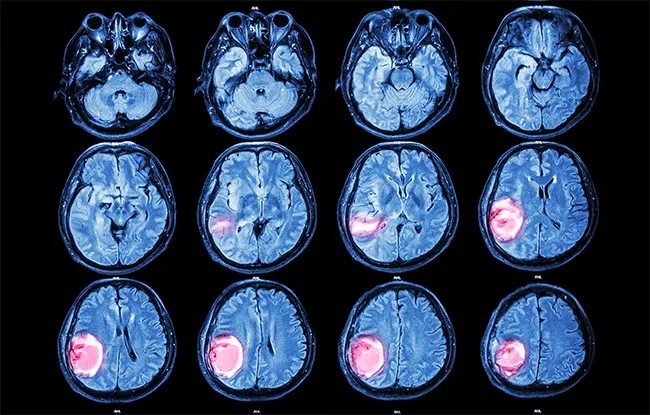- Home >
- Patients and Care >
- Cancer types >
- Central nervous system cancers >
- What are central nervous system cancers?
Central nervous system cancers

What are central nervous system cancers?
Tumors of the central nervous system, which affect the brain or the medullary canal containing the spinal cord (located in the spinal column), are divided into two main types: "primary" tumors, which originate in these areas, and "secondary" or metastatic tumors, which arise from a cancer that first developed in another organ (such as the breast or lung) and are therefore managed as part of the follow-up to this first cancer.
Primary tumors themselves fall into two categories:
- malignant tumors, which are relatively rare;
- and benign tumors, which account for two-thirds of all primary brain tumors.
Made up of non-cancerous cells, the latter can develop anywhere, particularly in the region of the pituitary gland. Depending on the cell type, they are called schwannomas, craniopharyngiomas, pituitary adenomas, meningiomas...
Malignant tumors include:
- gliomas (involving glial cells), the most common in adults. Glioblastoma, one of these, accounts for 20% of all brain tumors.
- rarer tumors, such as medulloblastomas (more common in children, most often arising in the cerebellum), ependymomas (which develop from ependymal cells in the brain or spinal cord), intracranial germ cell tumors, pineal region tumors (which arise in the pineal gland, also known as the epiphysis, and are more common in young adults) or primary brain lymphomas.
Institut Curie, an expert in treatment of central nervous system cancers
Thanks to its broad team of physicians, dedicated facilities, state-of-the-art equipment and network, Institut Curie is able to treat all types of CNS tumors. Its expertise is particularly recognized in the treatment of brain metastases and primary malignant tumors, as well as tumors of adolescents and young adults, and benign or rare tumors.
The expertise of Institut Curie is based on the solid experience of its specialized care departments treating a wide range of patients, for example with breast or lung cancer, or its pediatric oncology center SIREDO Care, Innovation & Research in Childhood, Adolescent and Young-Adult Oncology.
Many Institut Curie doctors are active members of national or international learned societies in the field, such as Anocef (Association des neuro-oncologues d'expression française). Institut Curie is also a national referral center for primary cerebral lymphomas, in partnership with the Assistance Publique - Hôpitaux de Paris (AP-HP), which acts as a referral center, organizing a nationwide multidisciplinary consultation meeting (RCP) and coordinating the development and dissemination of treatment guidelines.
Risk factors
Over 90% of primary brain tumors are of sporadic origin, with no identified cause. Certain genetic predisposition syndromes (linked to a gene anomaly) are at the origin of central nervous system tumor development, for example Li Fraumeni syndrome (TP53 gene anomaly), or neurofibromatosis type 2 (NF2 gene anomaly). Other risk factors for central nervous system cancers are poorly understood. Exposure to certain chemical substances, ionizing radiation or immunosuppression could be among them.

